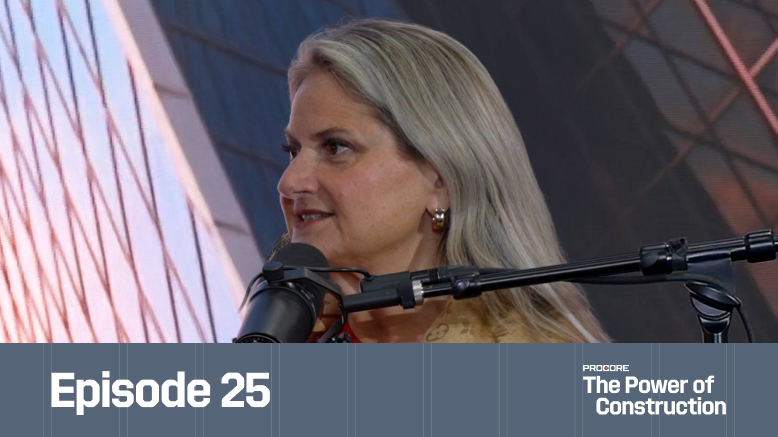— 8 min read
Construction Forecasting Beyond Financials: The Owner’s Guide


Last Updated Jul 11, 2025

Tara Cohn
Director
Tara Cohn is a director with over 15 years of experience in providing healthcare data analytics services. She helps leaders improve decision-making and achieve success with the use of data analytics. Tara’s experience includes provider practice, hospital/health system and healthcare startup/technology. She is a healthcare subject matter expert and has supported initiatives across operations, clinical care, quality, compliance, patient experience, population health, marketing, strategic planning, finance, revenue cycle and human resources. Tara’s passion is in leveraging data analytics to help organizations achieve their full potential with a focus on transparency, optimization and automation via the power of data storytelling.

Jonathan Greene
Writer
Jon Greene is a freelance educator, writer, and award winning theater maker. As an educational writer he has created content, lessons, and led seminars for Young Audiences of Louisiana, Hynes Charter System in New Orleans, Centre Stage School of the Arts in Singapore, 'Friends of The Museum' Docent Workshop in Singapore, The Prague Public High School System, Moleac Pharmaceuticals, and with the Grand Portage Ojibwa Tribe. His work and writing for theater has been featured in Howlround and American Theater Magazine and he is the recipient of 2 regional theater awards in his home of New Orleans. He is a BFA Graduate of Boston University and a previous Kennedy Center Fellow.

Brian Rockwell
Strategic Account Executive, Public Sector, Healthcare
Brian Rockwell has a comprehensive background in sales and leadership across various sectors, with a strong focus on government, education, and healthcare. Brian is currently a Strategic Account Executive for Public Sector Healthcare for Owners at Procore Technologies. This role places him at the intersection of technology and the construction industry, particularly in serving clients within the healthcare and public sectors, as well as project owners. His experience at Procore focuses on providing solutions that connect stakeholders, streamline workflows, and offer a consolidated view of construction projects, aiding in tasks, project management, and scheduling.

Jason Tessler
Strategic Product Consultant
Jason Tessler is a Strategic Product Consultant at Procore. He specializes in facilitating collaboration among owners, contractors, architects, and engineers to optimize project management processes and is based in the NYC metropolitan area.

Grant Honetschlager
Strategic Product Consultant, Owners
Grant Honetschlager is a Strategic Product Consultant at Procore specializing in its Financial and Preconstruction tools. Prior to joining Procore, Grant managed healthcare and life science construction projects in Southern California. Grant is passionate about helping clients gather data and insights from their projects in order to make informed decisions on design, capital planning, and project delivery methods.
Last Updated Jul 11, 2025

Just because a project is large in size, scope or social importance does not mean it will have infinite flexibility and budget. Projects can’t just change their offered service or timelines at the drop of a hat, and project owners and developers face a myriad of challenges from the very start — not to mention the ones that originate once the project is underway.
Financial forecasting is a useful strategy to understand where a project is, how it got there, what happens next and planning for the future. It’s a tactic that can mitigate risk and maximize success.
However, there’s more to forecasting than just the numbers. In this article, we'll discuss how project owners and developers can help their teams employ a forecasting mindset in all areas of a project — which can improve outcomes across the board.
Table of contents
Set your sights on every possible road.
Financial forecasting puts a forward-looking perspective on the numbers. Embracing this approach, both individually and with team members specifically tasked to look ahead, will give projects a malleable ethos in which any and all outcomes are possible.
Looking ahead is an investment.
Changing technology and advances in medicine can cause large adjustments in a project’s ability to meet the growing needs of the industry and its stakeholders. Sudden crises such as weather events only add to the uncertainty of a project’s relevancy once operational. That’s why it is in an owner or developer’s best interest to invest in looking ahead.
If owners want to be on the cutting edge they have to be willing to spend the extra time and money, so they don’t have to redo things in 10 years but instead 50 years.

Jason Tessler
Strategic Product Consultant
Procore Technologies
Master planning elevates opportunity.
Working closely with a master planner from the very start can help owners and developers hone their long term vision and plan for any complications that may arise.
Having a person on staff who is solely responsible for envisioning the future of the project allows more ideas to be possible. Even the loftiest ideas at design can be filtered through that master plan to have its feasibility tested later on. Doing it this way and this early keeps it clear, leaves enough time for feedback and avoids last-second shifts.
Be flexible and intentional.
Regardless of the size, scope or planning, no project will move through the phases without changes to schedule, timelines, financials or personnel. That’s why staying one step ahead by remaining intentional about your decisions and being flexible when handling them is an important aspect.
Balance cost and schedule.
Growing supply chain disruptions can make balancing cost and schedule difficult. Furthermore, owners and GCs may have different preferences regarding staying on schedule or staying on budget. Spreading out procurement locations and vendors and engaging a quicker purchasing strategy can be a successful maneuver to mitigate these problems.
One thing we see organizations doing is buying quicker. Understanding that a purchase now might create insulation from some of those financial hurdles down the road, but also creates a very different cash flow landscape than the original forecasts or projections.

Tara Cohn
Director
Wipfli LLP
Rolling forecasting keeps things current.
It’s not uncommon for subsequent cash flows to differ from their original forecasts. That’s because once a forecast is built around the original schedule, it's basically a guarantee that things are going to change.
A rigid insistence on a prior plan won’t tackle the problems in the immediate moment. Using rolling forecasting can be a successful way to keep track of the original financial parameters while accounting for new and unexpected financial changes.
This is not a one-and-done type activity, it ensures that you’re re-evaluating any changes that are happening to have a consistent and better understanding on the forecasted total for the project and having all owners, speciality and general contractors being in alignment — and keeping to it.
Tara Cohn
Director
Wipfli LLP
When creating such flexible forecasts, intentionality can be further expanded to consider the bigger unknowns facing the industry today. With governmental changes, possible tariffs and unpredictable natural occurrences like major storms or fires, it’s important to find the best ways to integrate those components into forecasting as well.
Stay updated on what’s happening in construction.
Subscribe to Blueprint, Procore’s free construction newsletter, to get content from industry experts delivered straight to your inbox.

Embrace collaboration.
Collaboration doesn’t mean egalitarianism or a world without strong leadership. The best road to a solid collaborative flow starts from the top. Owners and developers who embrace and encourage collaboration with their downstream partners will create teams capable of handling problems like disruptions, overruns and waste.
Encourage multiple perspectives.
Putting the right people together can yield big results. On projects with so many moving parts, specialty needs and long project leads, getting the right people together with leadership as early as possible puts the project and those involved a step ahead.
Good collaborative practices create mutual benefits for everyone. By including clinical, compliance, regulatory and construction expertise during planning and design phases it allows the integration of necessary reviews and checkpoints along the way rather than at the end. This alignment builds the trust necessary to hit the ground running addressing needs, decreasing risk and reducing expenses.
Breed success through transparency.
Perspective is influenced by the information at hand. If data isn’t readily available for all teams, or they have to parse through it to find their needs, a project can encounter slowdowns or become vulnerable to unexpected changes out of their control.
It’s important to have transparency and collaboration in place so when all the leaders and decision makers come together, they are able to look at it thoroughly and ask, ‘This is a notable change. How do we do this next week, month or year?’ Instances like that are where transparency leads to leveraging internal and external data that helps support the decisions that need to be made by the people who need to make them.
Tara Cohn
Director
Wipfli LLP
Remember: Compartmentalization hinders collaboration.
Maintaining uniformity from a stratified project becomes complicated the more teams can’t see the forest for the trees. Selecting the right number of teams you trust will make early communication clearer and long term collaboration more succinct.
I worked on a job that was one initiative with multiple sections outsourced to multiple contractors. It got to a point where we were a GC building one section and across the way is another and our two projects were meant to be connected by a piece of the initiative which had not been assigned to either of us...So we had the design for our section ready but we couldn’t build out on our schedule until we heard back from elsewhere. There was a point where we just didn’t know what to do with this situation.

Grant Honetschlager
Strategic Product Consultant, Owners
Procore Technologies
Over-fragmentation of a project can hinder progress and inflate budgets due to miscommunication, duplicated efforts, schedule conflicts between teams and change orders arising from incomplete information. In the end it will be the owner left responsible for untangling the knot of a confusing and possibly irreparable build.
In the short run, chopping up sections of a project and bidding them out to multiple firms can decrease the bottom line but can ignore the possibility of unseen costs incurred from an over-complicated work flow.
Depend on data.
Forecasting requires a deep understanding of all the numbers, not just the financial ones.
Schedules, logs, pricing charts, market information, vendor details, previous analytics and more are all part of the large bundle of data that gets accumulated over the life of a project.
In the end, scheduling and forecasting go hand in hand — and it really depends on what the key performance indicators are for senior management to see from that perspective and make the right decisions.

Brian Rockwell
Strategic Account Executive, Public Sector, Healthcare
Procore Technologies
Before an owner can utilize this data with the digital tools at their disposal, they have to be able to correctly identify the good data that will be usable for them and their projects.
Software can save time.
Utilizing software and staff to keep data updated and available is in an owner’s best interest. An investment in time and efficacy can yield opportunities to utilize funds on other projects and improve work across a larger portfolio.
Say you’re under budget on a project by $10 million. At that point, you should be forecasting out to see if that will be utilized at some point during the project. If not, then you may be able to shift those funds to that high-value project that wasn’t funded previously.
Brian Rockwell
Strategic Account Executive, Public Sector, Healthcare
Procore Technologies
With a clear handle on the best data that illuminates before, during and after a project’s life, owners can proactively respond to complications, make the necessary changes, keep the pace up and make sure the ROI remains in the black.
Crunching and cross-referencing can happen at the start.
Having the data at your fingertips means you can look at it from a variety of perspectives. This gives owners and developers the opportunity to think deeply about financial needs in light of time constraints, schedule hiccups and more.
Investment in strong construction management software that can put the most useful data from multiple vantage points in front of you can create an advantage when dealing with interruptions that affect the long term operational efficiency of a healthcare project.
Looking Beyond the Forecast
Given the unforeseen challenges a project can encounter, its owners need to be mindful that financial forecasting alone is not enough.
It's equally important to apply the concepts of forecasting beyond the numbers to include other critical aspects of the project such as the schedule, acquiring good data and breaking free of communication silos to increase collaboration both vertically and horizontally.
Was this article helpful?
Thank you for your submission.
0%
0%
You voted that this article was . Was this a mistake? If so, change your vote
Scroll less, learn more about construction.
Subscribe to The Blueprint, Procore’s construction newsletter, to get content from industry experts delivered straight to your inbox.
By clicking this button, you agree to our Privacy Notice and Terms of Service.
Thank you!
You’re signed up to receive The Blueprint newsletter from Procore. You can unsubscribe at any time.
Categories:
Written by

Tara Cohn
Director | Wipfli LLP
Tara Cohn is a director with over 15 years of experience in providing healthcare data analytics services. She helps leaders improve decision-making and achieve success with the use of data analytics. Tara’s experience includes provider practice, hospital/health system and healthcare startup/technology. She is a healthcare subject matter expert and has supported initiatives across operations, clinical care, quality, compliance, patient experience, population health, marketing, strategic planning, finance, revenue cycle and human resources. Tara’s passion is in leveraging data analytics to help organizations achieve their full potential with a focus on transparency, optimization and automation via the power of data storytelling.
View profile
Jonathan Greene
Writer
Jon Greene is a freelance educator, writer, and award winning theater maker. As an educational writer he has created content, lessons, and led seminars for Young Audiences of Louisiana, Hynes Charter System in New Orleans, Centre Stage School of the Arts in Singapore, 'Friends of The Museum' Docent Workshop in Singapore, The Prague Public High School System, Moleac Pharmaceuticals, and with the Grand Portage Ojibwa Tribe. His work and writing for theater has been featured in Howlround and American Theater Magazine and he is the recipient of 2 regional theater awards in his home of New Orleans. He is a BFA Graduate of Boston University and a previous Kennedy Center Fellow.
View profileReviewed by

Brian Rockwell
Strategic Account Executive, Public Sector, Healthcare | Procore Technologies
Brian Rockwell has a comprehensive background in sales and leadership across various sectors, with a strong focus on government, education, and healthcare. Brian is currently a Strategic Account Executive for Public Sector Healthcare for Owners at Procore Technologies. This role places him at the intersection of technology and the construction industry, particularly in serving clients within the healthcare and public sectors, as well as project owners. His experience at Procore focuses on providing solutions that connect stakeholders, streamline workflows, and offer a consolidated view of construction projects, aiding in tasks, project management, and scheduling.

Jason Tessler
Strategic Product Consultant | Procore Technologies
Jason Tessler is a Strategic Product Consultant at Procore. He specializes in facilitating collaboration among owners, contractors, architects, and engineers to optimize project management processes and is based in the NYC metropolitan area.
View profile
Grant Honetschlager
Strategic Product Consultant, Owners | Procore Technologies
Grant Honetschlager is a Strategic Product Consultant at Procore specializing in its Financial and Preconstruction tools. Prior to joining Procore, Grant managed healthcare and life science construction projects in Southern California. Grant is passionate about helping clients gather data and insights from their projects in order to make informed decisions on design, capital planning, and project delivery methods.
View profileExplore more helpful resources

Defending Against Financial & Legal Risks on Megaprojects
The construction industry has seen marked growth in megaprojects. Some experts classify any project over $500 million as a megaproject, while others argue that the build needs to be $1...

Unlocking Project Intelligence: Moving from Raw Data to Actionable Insights
The construction industry faces a wide range of challenges, from ongoing labor shortages to frequent cost overruns. But some the biggest hurdles all stem from unpredictability. The general contractors (GCs)...

Who is accountable for innovation in construction?
Everyone says construction needs to innovate—but no one agrees on who’s actually responsible for making it happen. Is it the owner? The builders? The tech vendor? Or is innovation everyone’s...

Integrated Project Delivery in Practice: A Framework for Collaboration
On construction projects, traditional delivery methods put different stakeholders in their own silos. While the design team feeds drawings and specifications to the general contractor (GC), the GC’s expertise in...
Free Tools
Calculators
Use our calculators to estimate the cost of construction materials for your next project.
Templates
Find a template to help you with your construction project tasks.
Material Price Tracker
Get the latest U.S. retail prices and view historical trends for common building materials.
Glossary
Explore key terms and phrases used in the industry.
